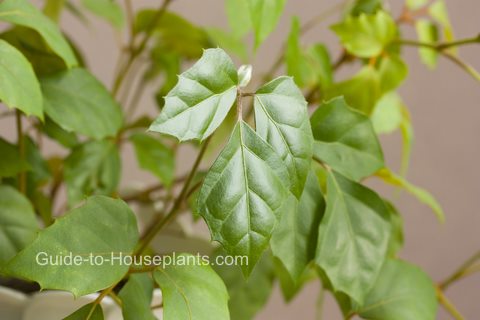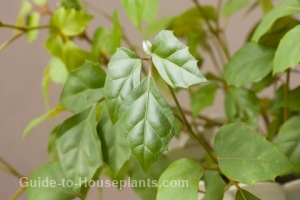Grape Ivy Plant Care – Types of Cissus rhombifolia as House Plants
Botanical Name: Cissus rhombifolia
Grape Ivy is a vigorous, evergreen vine with handsome, glossy compound leaves, each bearing 3 leaflets. Young leaves are fuzzy, giving them a silvery sheen. It’s extremely adaptable to indoor conditions and makes an easy house plant.
Pot this vine in a hanging basket to show off its beautiful trailing foliage. Large plants can be trained up a trellis or moss pole. Its sturdy vines will scramble up any support, climbing and clinging with its curling tendrils.

Pinch and prune. Growing tips are tender and can be pinched off with your fingernails. Regular pinching will keep your grape ivy plant compact and bushy. Don’t toss out those stem tips either. You can propagate them for more plants.
Control the plant’s size by pruning every spring. Use sharp pruners and always cut at a 45° angle after a leaf node (the place where a leaf attaches to the stem). If a lower stem becomes bare, don’t be afraid to cut it back at the soil level; this vigorous grower will quickly grow new stems.
Repot in spring every couple years or when roots fill the pot. Use one with drainage holes to prevent soggy soil and root rot. Want to use a planter without holes? Just slip a plain nursery pot into a cachepot (a decorative plant pot without drainage). I put small rocks in the bottom of my cachepots to keep the nursery pot above the drainage water.
Give it a rest in winter. Grape ivy doesn’t go dormant in the winter, but growth slows down with fewer hours of daylight. One of the common problems with plant care is overwatering. Allow soil to dry out a bit between waterings in winter and stop fertilizing until spring.
Something bugging your plant? Aphids are small green or black insects that are attracted to new growth on this soft-stemmed plant. Rinse them off by spraying with water. Grape ivy is sensitive to pesticides and some types of insecticidal soap or oil; it’s a good idea to test any insect spray on one leaf first. Red spider mites are so tiny, you’ll likely only notice the fine webbing between stems. Isolate your plant and cut off any infested leaves and stems. Use a soft cloth to gently clean the undersides of remaining leaves. If your plant is badly infested, get rid of it — you don’t want those destructive critters to destroy your other house plants. Spider mites are attracted to dry conditions, so mist Grape Ivy often with a fine spray of water to raise the humidity.
Types of Grape Ivy for Sale
Did You Know?
Grape ivy is in the Vitaceae family along with Vitis vinifera — the much-cultivated vines grown for grapes, wine, and preserves.
You’ll find Cissus rhombifolia for sale in spring and summer in garden centers and some online nursery sites. C.r. ‘Ellen Danica’ is a popular variety, also called Oak Leaf Ivy for its deeply lobed leaves. ‘Mandiana Compacta’ is dwarf and compact, making it easy to train on a small trellis.
Kangaroo Vine (C. antarctica) is an Australian native with single pointed, toothed leaves.
Grape Ivy Plant Care Tips

Origin: South America
Height: Size varies with variety. Some plants will climb up to 6 ft (1.8 m) or more with support. You can keep it to 2 ft (60 cm) with pruning.
Light: Bright indirect sunlight. Protect your plant from direct sun, which can cause brown scorch marks on the leaves. Grape Ivy also grows well under fluorescent light.
Water: Water generously throughout the growing season, keeping the soil evenly moist. Water less in winter, allowing the top 1 inch (2.5 cm) of soil to dry between waterings. Shriveled leaves that fall off are a sign the soil is either too wet or too dry.
Humidity: Grape ivies like relative humidity near 40-60%. Brown leaf tips are sometimes caused by dry air. Using a humidity tray can help, but give your ivy plant good air circulation to prevent powdery mildew.
Temperature: Warm in spring and summer (65-80°F/18-27°C). Slightly cooler in fall and winter (55-70°F/13-21°C).
Soil: Peat moss-based potting mix, such as African violet potting mix.
Fertilizer: Feed monthly in spring and summer with a balanced water-soluble fertilizer diluted by half.
Propagation: Take 3-4 in (7.5-10 cm) stem tip cuttings in late spring. Strip off the lower leaves and dip cut ends in rooting hormone powder. Then insert cuttings in a 1:1 mixture of moist peat and perlite. Enclose the pot in a plastic bag to maintain humidity. Roots should grow in 6-8 weeks.




